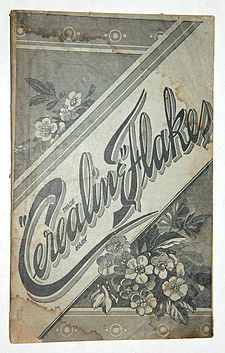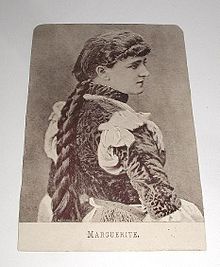- Cerealine
-
Cerealine, also known as malt flakes, was a popular 19th century American cereal product and the first dry breakfast food. Similar to but predating corn flakes, which appeared in 1898 and are first rolled and then toasted, cerealine is corn grits in the form of uncooked flakes. It was originally used by the brewing industry.
More popularly, Cerealine Flakes, colloquially called simply Cerealine, was also the brand name for raw-flake cereal made from grits by the Cerealine Manufacturing Company of Indianapolis, Indiana, USA.
Contents
History
After having long been used for beer brewing, cerealine in the late 19th century became one of the three most popular cereals of that time, along with cracked wheat and oatmeal. All three were typically sold by retailers who bought cereal in barrel lots and scooped it out to sell by the pound to customers. Cerealine Flakes was later sold in packages.
White-corn cerealine flakes were invented, perhaps accidentally, by Columbus, Indiana mill worker James Vannoy circa 1884[1] or 1887.[2] Cerealine was established as a breakfast food by at least 1897, when the Illinois Farmer's Institute annual report noted that, "Some mills make hominy of white corn, roll it into broad, flat flakes, called cerealine, which are used here as a breakfast dish...."[3]
Cerealine Manufacturing
Aurora, Indiana's T. & J.W. Gaff & Co. distillery built the Cerealine Mill,[4] at 607 Jackson Street in Columbus, Indiana, in 1867. Their Cerealine Manufacturing Company moved to Indianapolis, Indiana[5] sometime prior to 1898,[6] though the Columbus mill's building remained extant and was restored in the late 20th or early 21st century[7] for use as a cafeteria and conference center[8] by the engine manufacturing corporation Cummins Inc.[9]
Prior to being annexed by Indianapolis in 1895, the settlement around what was then called the Cerealine Works was known as Cerealinetown.[10]
References
- ^ TripTrivia.com: Columbus, Indiana Tourism. WebCitation archive.
- ^ James Vannoy obituary, The Evening Republican, July 22, 1902, via Vannoy Genealogy. WebCitation archive.
- ^ Mills, Charles F. ed. Annual Report, Illinois Farmer's Institute with Reports of County Farmers' Institutes for the Year 1897 (Phillips Bros., State Printers, Springfield, Ill.) p. 122
- ^ "History of Hillforest". Hillforest.org. Archived from the original on July 26, 2011. http://web.archive.org/web/20110726151830/http://www.hillforest.org/history.php.
- ^ Hart, Rev. Charles Coffin. Joseph Hart and His Descendants (1901), Gideon B. Hart. WebCitation archive.
- ^ Indianapolis Sanborn Map #61, 1898, The Digital Collections of IUPUI University Library. WebCitation archive.
- ^ Repp and Mundt: Restoration. Includes image of building. WebCitation archive.
- ^ Cummins Engine Co., Cartage.org, n.d. WebCitation archive.
- ^ "Columbus Indiana Pictures and Photos From Bygone Days", p. 8. HistoricColumbusIndiana.org, n.d. Includes image of building. WebCitation archive.
- ^ "Preservationists aim to save historic schools and taxpayer money". Historic Landmarks Foundation of Indiana press release. October 20, 2002. Archived from the original on July 16, 2007. http://web.archive.org/web/20070716025327/http://www.historiclandmarks.org/news/2002releases/release103002a.html.
External links
- Carson, Gerald. "None Genuine Without this Signature" chapter, Cornflake Crusade (Rinehart & Company, New York, 1957), pp. 200-211. Archived from the original March 3, 2011.
Categories:- Breakfast cereals
- Raw foods
Wikimedia Foundation. 2010.


